BEST BUY
Client: Best Buy, Website
Team Members: Laken Lam, Alexis Brodie, Vriti Wadhwa, Mohammed El-Khetchen
Programs: Treejack by Optimal Workshop, Draw.io, Figma
Skills: User Research, Usability Testing, Tree Testing, Schematic Diagrams, Interviews, Card Sorting, Wireframing and Prototyping
Objective: To enhance the information architecture of the Best Buy Canada website.
Research Methods
Interviews - Our team conducted interviews to understand the preferences, paint points and experiences of users.
Usability Tests - Our team also conducted usability testing to understand the challenges and accomplishments of the website. Participants performed a usability test which included recalling the landing page, identifying a specific product in the “Top Deals” page, and to complete a purchase by finding, selecting, and adding the item to the cart.
Key Findings
Overwhelming and inconsistent information made it hard for users to focus on completing their usability testing.
Site navigation and labels were not user friendly, which forced users to use the search bar and defeated the purpose of the primary navigation bar.
Users had difficulty interpreting terms and found it a challenge to locate desired products
Card Sort
We conducted a 45 card sort test with users of diverse backgrounds. There was confusion in the organization of the “Shop”, “Brands”, “Deals” and “Services” categories. We found that users catergoized majority of the “savings, gifts, and deals” cards in the “Deals'' category as opposed to the “Shop” category.
Other categories were not clear enough and forced users to create new categories. This emphasized that the primary navigation structure was incoherent and needed to be reworked.
IA Schematic Diagram
Our goals to rework the IA schematic diagram by rewording labels, regrouping labels, and clarifying navigation bar labels. Key successes included:
Increased Clarity - We made the labels easier to understand by combining duplicate categories and using easier to distinguish.
“Deals” label reorganized to include additional branches of “Everyday Deals,” “Refurbished Deals,” “Deals by Brands,” and “Deals by Season”, resulting in more consistent organization;
“Major Appliances” and “Small Kitchen Appliances” relabelled as “Large Appliances” and “Small Appliances” for easier understanding;
“Service” label reorganized to include “Geek Squad Tech Support and Installations,” “Business Support,” “Accessibility & Care Giving Support through Tech,” “Trade-In Old Tech,” and “Green initiative: electronic recycling program” for easier access of different types of services; and
“Brands” label expanded to include “Browse Popular Brands” and “Browse Brands Alphabetically”, providing more options to explore products.
Reducing categories
We were able to reduce the number of branches from 26 to 22 branches, resulting in less information overload.
Initial IA Diagram
Reworked IA Diagram
Tree Test
We conducted a tree test with 11 users. We instructed the users to find specific Best Buy products using the redesigned navigation. However, our success rate of the tree test was low with an average success rate of 35% and average directness score of 57%. Therefore, we further reworked the labels and cateorgories by using more coherent and easier to understand wording and shortened catergory titles.
Final IA Diagram
Conclusion
This project taught me how user experience design is built on users' needs, preferences, pain points, and behaviours. From research and testing, I learned to reorganize and structure content for easier understanding and accessibility. IA plays an integral part in ensuring that users can navigate websites without confusion.








